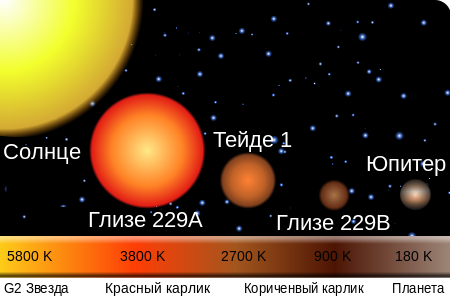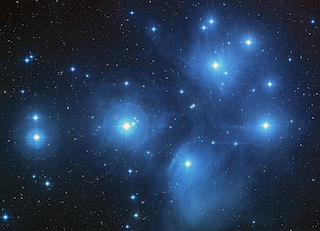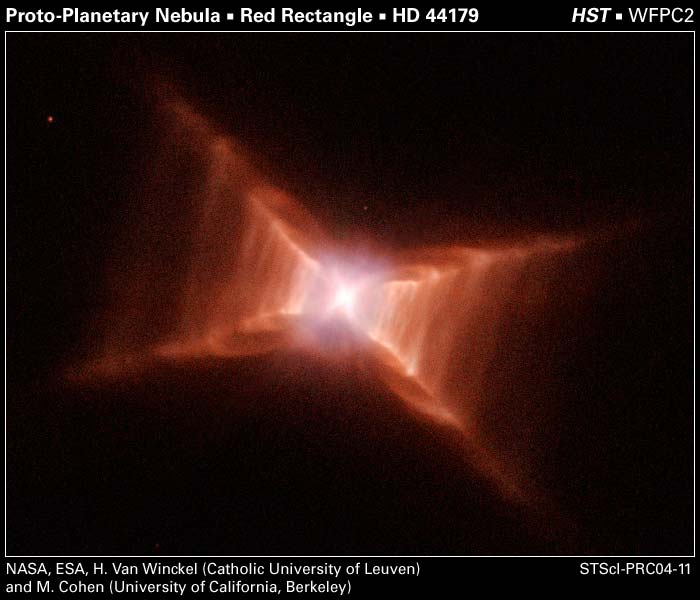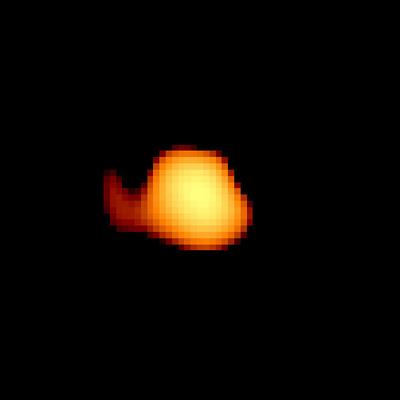Stars as we do not see them
I know that a huge audience share of this resource is specialists in various branches of science.
But I also know that I visit him and quite a few people who are simply interested in natural phenomena (I consider myself to be of this type), which does not detract, their desire to know the Universe as far as imagination and patience suffice!
Therefore, this article has a goal to entertain and, perhaps, push someone to study the issue in more depth, as well as simply introduce a new vision and presentation of seemingly familiar things.

')
The fact that a person can see in the sky even close does not look like what is actually happening there. What we see is a very diminished past of our universe. Therefore, when it comes to stars, a person usually either has an image of bright dots in the sky, or something very reminiscent of our Sun, soaring in the depths of space.
In fact, most stars are these “boring” gas, brightly glowing balls. But there is something incredible in the vastness of space! Although it looks to us the same small and dim point in the sky.
I will not here scientifically describe the evolution of stars or the Herzshprung-Russell diagram . I want to show how diverse the concept of "star" is and how much this diversity is incompatible with the fact that we have invested in this term since childhood (and some, like me, until later).
For example, here's a star for you - Gliese 229B. Brown dwarf

This is the exact opposite of the meaning of the word itself - “star” - brilliance, radiance.
Our Jupiter is very similar to this star, and even, in fact, is not much different from it, but there are still differences. Although the radius of these stars is comparable to the radius of the giant planets, they are, in general, ten times more massive, and also radiate in the infrared and X-ray range.
Flying next to such a star, we will see it look like a kind of lamp-night light. No crown, bright glow, squinting eyes and the like. Imagine that you are looking at the sun through a welding mask. Reddish glowing planet of hot lava - this is how this star would look to our eyes. And this is at best.
Ultra-cold brown dwarfs do not shine at all!
Being nearby, we would most likely see just a dark orb overlapping the starry sky. And if the distance from us to the star were the same as from Earth to the Sun, we generally would most likely not know that we were flying past the star! Any planet is usually illuminated by a star in the center of its orbit, but ultra-cold brown dwarfs are what it is, therefore there is no one to light them.
It is also interesting that planetary systems are also possible around brown dwarfs! Scientists have discovered that often these, and so dim stars, are surrounded by a disk of dust, similar to the one from which our solar system was formed.
It is sad that in the sky with an unalloyed eye we cannot see a single brown dwarf. Even in the mountains and with the best weather to observe.
We are lucky if our dwarf is part of a star system. A star system is two or more stars connected together by gravitational forces.
For example, telescopes see a dual system, of which the aforementioned Gliese 229B (the small ball on the right) is a part.

In such a system, an ultra-cold brown dwarf would look very similar to some kind of gas giant planet rotating in a low orbit around a "normal" star.
It turns out that the system of stars is not such a rare occurrence. And this is another amazing fact. Some of the stars that we see are, in fact, huge star clusters, which seem to us to be one bright star because of the huge distance to them. And some - not so huge - the so-called multiple stars. Let us dwell on each of the systems in more detail.
Take any two stars in the sky that seem close to us. In fact, almost all of them are distant from each other "deep into" the cosmos. Almost all. There are exceptions.

For example, in the sky, well distinguished for our eyes Pleiades. This is a star cluster in which the stars are actually “close” to each other. I wrote "close" in quotes - because the distance between them is calculated in light years. Cluster radius is about 12 light years. For comparison, if our Solar System were located approximately in the center of the Pleiades, then the most distant star of the cluster would be one and a half times farther than the Alpha Centauri nearest to us.
If the weather is good and far from cities, 10-14 of the brightest representatives of this cluster can be distinguished, but in fact there are about 1000 of them there! The sky on the planet inside the Pleiades would look just magical! The clusters are mostly bright blue giants. They would have decorated the sky with beautiful bluish-white lights, but, unfortunately, they would not have given birth to a life similar to ours because of the destructive radiation that literally penetrates the entire area of this star system.
In clusters, stars usually do not have a clear center of mass. But there are systems, like Gliese mentioned above, consisting of a multiple of stars that are very close to each other, even by the standards of our Solar System, and revolve around a common center of mass. They are called multiple systems of stars, or simply multiple stars.
A good example is the Mizar-Alcor system in the constellation Ursa Major.

Look at the Big Dipper, even not far from the city you can notice that the second star of the bucket (Mizar) in the constellation actually consists of two stars, the other - the smaller one - is Alcor. She is actually physically close to her neighbor, as it seems to us - at a distance of a quarter of a light year. But even more interesting is that we see two stars, and there are six of them in this system!
And such multiple stars, as it turned out, are not uncommon. Very many of the stars that we see in the sky and consider single, in fact, double, triple,quadruple, fivefold and more! Why do we not notice this? Because, as a rule, either “secondary” stars are too dim on the background of “primary”, which are many times brighter, or the distance between them is so small that our eye simply does not have enough permission to divide neighbors into separate objects at a great distance.
In such systems, most often the most interesting thing is that different types of stars can be neighbors!
Sirius - the brightest star in the sky - actually double.

The main star is quite ordinary and unremarkable. In size, it is only 1.7 times the size of our Sun. It only shines 22 times brighter and in a more white-bluish light, unlike our luminary. Her companion, Sirius B, is a white dwarf. Its radius is approximately equal to the radius of our Earth, and its mass is approximately equal to the mass of our Sun!
The white dwarf is a small dim star, in the past it is the core of a red giant. The formation of such stars, without going into complex details, can be explained by the victory of gravity. The termination of internal thermonuclear reactions in the red giant leads to the release of its shell and the incredibly strong compression of the nucleus. The substance of the star is so tightly contained in a small volume that 1 cubic centimeter of its substance would weigh 10 tons on Earth! In spite of the seemingly boring view (when flying nearby, we would see a white, brightly glowing ball, the size of a planet), the beauty of white dwarfs in their environment. Often a powerful explosion tears matter from the surface of a red giant and spreads it at an enormous speed into the surrounding space. The resulting cloud, which we know as a nebula, pleases our eye with all the colors of the chemical elements that once formed in the depths of a perishing star.


In the second picture, the NGC 3132 nebula. Here the main star is not a white dwarf (it is slightly smaller and a little higher), but it was he who caused the main star to discharge matter. Imagine what beauty we could observe, being inside this nebula - in the orbit of this double star. We would have to arm the eye, nevertheless, to see something more than the usual sky with stars. So beautiful nebula looks only from afar. From a long distance, the cloud seems dense, but in reality, the substance is strongly dispersed, and near, most likely, is no different from our night sky. However, putting the camera on a long exposure on a hypothetical planet next to the central star, we would see a fantastic beauty of the sky - a colorful nebula on the entire sky with all its jumpers!
Remember the beautiful color photos of the Milky Way. They are made with great exposure. Our eye sees nothing of the kind.

Having a small size, a white dwarf, due to its huge mass, has a significant gravitational effect on its environment. Here, for example, a photo where, even though the dwarf itself is not visible, its influence is clearly visible.

Here the sphere on the right is a giant star, the substance of which is mercilessly devoured by the white dwarf on the left. In the process, the substance flows from one neighbor to another, twisting around a massive (albeit scanty compared to the victim) star and gradually settles on its surface. An accretion disk is formed - a very beautiful phenomenon from the point of view of observation. Imagine the rings of Saturn, which glow like the sun. Only these rings are much larger, twisted in a spiral and one of the ends of the rings goes straight into the star's body, forming an elongation in the form of a giant wave on its surface! And in our sky, we can instead observe the usual luminous point.
Let us turn to the brother of the white dwarf - the neutron star.
When a red giant says goodbye to life, he has a chance to produce something more dense than a white dwarf. If the star's mass exceeds the Chandrasekhar limit, a neutron star is formed from the giant's core. Its mass is still comparable to the mass of the Sun, but the size is absolutely amazing - the radius of neutron stars is only 10-20 kilometers! Due to the rapid decrease in size, like a skater, unwinding due to the attraction of hands to the body, these stars rotate at incredible speeds! Many of the neutron stars rotate at speeds of up to 1000 revolutions per second. This is about 10 times faster than the crankshaft of the car at maximum speed!
Interestingly, due to gravitational distortion, if we could see the surface heterogeneity of a neutron star, we would see more than half of the disk.

Neutron stars are also part of multiple systems and form accretion disks.
Speaking of accretion disks, it is worth noting the Cygnus X-1 system. Although there, according to scientists, is a black hole. In essence, this system is the first candidate for black holes. The fact is that Cygnus X-1 strongly radiates in the X-ray range, and this is the first sign of the presence of a black hole and an accretion disk around it, formed by a donor - a nearby blue supergiant.
I do not advise to fly close to such systems, powerful radiation will kill all life on your spacecraft for a long time before you approach at least enough to distinguish the accretion disk from the brightness of the giant.
The accretion disk in the film Interstellar is very beautifully shown. But, there, unfortunately, there was no star-victim.
Black holes are not exactly stars, and deserve, perhaps, a separate article, of which there are a huge amount on the Internet.
Finally, I would like to talk about the stars with planetary systems. The discovery of exoplanets began relatively recently, but the number of already found planets and candidates is amazing! Just over the past year, a little less than a thousand exoplanets have been discovered!
Remember when you looked at the sky 10-15 years ago, could you think that billions of planets revolve around the stars you see? (Judging by the article on Wikipedia, there are about 100 billion planets in the Milky Way. )
What planetary systems look like — we can tell from experience — is pretty boring if you are not near any of the planets.
But if the planets are just being formed, the spectacle becomes much more interesting! Dust and gas gather around a common center - a glowing cloud, forming a disc-like nebula, illuminated from the inside. The star in the center does not yet have clear boundaries, and a denser cloud around it does not allow seeing it. Clots, which in the future may become planets, cast even shadows going to the edges of the disk.
Most likely, we don’t even need to arm our eyes here - the softness and illumination of matter will allow us to observe the birth of a new Star System in all its glory.
It is amazing how much our ancestors put into the concept of the Star, and how much has been added to it over the past centuries! It only remains to wait for humanity to be able to freely study the heavenly bodies directly approaching them, in order to personally confirm the theories that are open on the tip of the pen. What other beautiful photos will be filled with scientific articles? What kind of world will become the stars for the future of us? ..
PS
I deliberately did not spread here numerous paintings of stars in the representation of artists. Only photos and diagrams. I heard somewhere - that the best video card in the world is our imagination!
But I also know that I visit him and quite a few people who are simply interested in natural phenomena (I consider myself to be of this type), which does not detract, their desire to know the Universe as far as imagination and patience suffice!
Therefore, this article has a goal to entertain and, perhaps, push someone to study the issue in more depth, as well as simply introduce a new vision and presentation of seemingly familiar things.

')
So about the stars
The fact that a person can see in the sky even close does not look like what is actually happening there. What we see is a very diminished past of our universe. Therefore, when it comes to stars, a person usually either has an image of bright dots in the sky, or something very reminiscent of our Sun, soaring in the depths of space.
In fact, most stars are these “boring” gas, brightly glowing balls. But there is something incredible in the vastness of space! Although it looks to us the same small and dim point in the sky.
I will not here scientifically describe the evolution of stars or the Herzshprung-Russell diagram . I want to show how diverse the concept of "star" is and how much this diversity is incompatible with the fact that we have invested in this term since childhood (and some, like me, until later).
Brown dwarf
For example, here's a star for you - Gliese 229B. Brown dwarf

This is the exact opposite of the meaning of the word itself - “star” - brilliance, radiance.
Our Jupiter is very similar to this star, and even, in fact, is not much different from it, but there are still differences. Although the radius of these stars is comparable to the radius of the giant planets, they are, in general, ten times more massive, and also radiate in the infrared and X-ray range.
Flying next to such a star, we will see it look like a kind of lamp-night light. No crown, bright glow, squinting eyes and the like. Imagine that you are looking at the sun through a welding mask. Reddish glowing planet of hot lava - this is how this star would look to our eyes. And this is at best.
Ultra-cold brown dwarfs do not shine at all!
Being nearby, we would most likely see just a dark orb overlapping the starry sky. And if the distance from us to the star were the same as from Earth to the Sun, we generally would most likely not know that we were flying past the star! Any planet is usually illuminated by a star in the center of its orbit, but ultra-cold brown dwarfs are what it is, therefore there is no one to light them.
It is also interesting that planetary systems are also possible around brown dwarfs! Scientists have discovered that often these, and so dim stars, are surrounded by a disk of dust, similar to the one from which our solar system was formed.
It is sad that in the sky with an unalloyed eye we cannot see a single brown dwarf. Even in the mountains and with the best weather to observe.
Star systems
We are lucky if our dwarf is part of a star system. A star system is two or more stars connected together by gravitational forces.
For example, telescopes see a dual system, of which the aforementioned Gliese 229B (the small ball on the right) is a part.

In such a system, an ultra-cold brown dwarf would look very similar to some kind of gas giant planet rotating in a low orbit around a "normal" star.
It turns out that the system of stars is not such a rare occurrence. And this is another amazing fact. Some of the stars that we see are, in fact, huge star clusters, which seem to us to be one bright star because of the huge distance to them. And some - not so huge - the so-called multiple stars. Let us dwell on each of the systems in more detail.
Take any two stars in the sky that seem close to us. In fact, almost all of them are distant from each other "deep into" the cosmos. Almost all. There are exceptions.

For example, in the sky, well distinguished for our eyes Pleiades. This is a star cluster in which the stars are actually “close” to each other. I wrote "close" in quotes - because the distance between them is calculated in light years. Cluster radius is about 12 light years. For comparison, if our Solar System were located approximately in the center of the Pleiades, then the most distant star of the cluster would be one and a half times farther than the Alpha Centauri nearest to us.
If the weather is good and far from cities, 10-14 of the brightest representatives of this cluster can be distinguished, but in fact there are about 1000 of them there! The sky on the planet inside the Pleiades would look just magical! The clusters are mostly bright blue giants. They would have decorated the sky with beautiful bluish-white lights, but, unfortunately, they would not have given birth to a life similar to ours because of the destructive radiation that literally penetrates the entire area of this star system.
In clusters, stars usually do not have a clear center of mass. But there are systems, like Gliese mentioned above, consisting of a multiple of stars that are very close to each other, even by the standards of our Solar System, and revolve around a common center of mass. They are called multiple systems of stars, or simply multiple stars.
A good example is the Mizar-Alcor system in the constellation Ursa Major.

Look at the Big Dipper, even not far from the city you can notice that the second star of the bucket (Mizar) in the constellation actually consists of two stars, the other - the smaller one - is Alcor. She is actually physically close to her neighbor, as it seems to us - at a distance of a quarter of a light year. But even more interesting is that we see two stars, and there are six of them in this system!
And such multiple stars, as it turned out, are not uncommon. Very many of the stars that we see in the sky and consider single, in fact, double, triple,
In such systems, most often the most interesting thing is that different types of stars can be neighbors!
Sirius - the brightest star in the sky - actually double.

The main star is quite ordinary and unremarkable. In size, it is only 1.7 times the size of our Sun. It only shines 22 times brighter and in a more white-bluish light, unlike our luminary. Her companion, Sirius B, is a white dwarf. Its radius is approximately equal to the radius of our Earth, and its mass is approximately equal to the mass of our Sun!
Superdense stars
The white dwarf is a small dim star, in the past it is the core of a red giant. The formation of such stars, without going into complex details, can be explained by the victory of gravity. The termination of internal thermonuclear reactions in the red giant leads to the release of its shell and the incredibly strong compression of the nucleus. The substance of the star is so tightly contained in a small volume that 1 cubic centimeter of its substance would weigh 10 tons on Earth! In spite of the seemingly boring view (when flying nearby, we would see a white, brightly glowing ball, the size of a planet), the beauty of white dwarfs in their environment. Often a powerful explosion tears matter from the surface of a red giant and spreads it at an enormous speed into the surrounding space. The resulting cloud, which we know as a nebula, pleases our eye with all the colors of the chemical elements that once formed in the depths of a perishing star.


In the second picture, the NGC 3132 nebula. Here the main star is not a white dwarf (it is slightly smaller and a little higher), but it was he who caused the main star to discharge matter. Imagine what beauty we could observe, being inside this nebula - in the orbit of this double star. We would have to arm the eye, nevertheless, to see something more than the usual sky with stars. So beautiful nebula looks only from afar. From a long distance, the cloud seems dense, but in reality, the substance is strongly dispersed, and near, most likely, is no different from our night sky. However, putting the camera on a long exposure on a hypothetical planet next to the central star, we would see a fantastic beauty of the sky - a colorful nebula on the entire sky with all its jumpers!
Remember the beautiful color photos of the Milky Way. They are made with great exposure. Our eye sees nothing of the kind.

Having a small size, a white dwarf, due to its huge mass, has a significant gravitational effect on its environment. Here, for example, a photo where, even though the dwarf itself is not visible, its influence is clearly visible.

Here the sphere on the right is a giant star, the substance of which is mercilessly devoured by the white dwarf on the left. In the process, the substance flows from one neighbor to another, twisting around a massive (albeit scanty compared to the victim) star and gradually settles on its surface. An accretion disk is formed - a very beautiful phenomenon from the point of view of observation. Imagine the rings of Saturn, which glow like the sun. Only these rings are much larger, twisted in a spiral and one of the ends of the rings goes straight into the star's body, forming an elongation in the form of a giant wave on its surface! And in our sky, we can instead observe the usual luminous point.
Let us turn to the brother of the white dwarf - the neutron star.
When a red giant says goodbye to life, he has a chance to produce something more dense than a white dwarf. If the star's mass exceeds the Chandrasekhar limit, a neutron star is formed from the giant's core. Its mass is still comparable to the mass of the Sun, but the size is absolutely amazing - the radius of neutron stars is only 10-20 kilometers! Due to the rapid decrease in size, like a skater, unwinding due to the attraction of hands to the body, these stars rotate at incredible speeds! Many of the neutron stars rotate at speeds of up to 1000 revolutions per second. This is about 10 times faster than the crankshaft of the car at maximum speed!
Interestingly, due to gravitational distortion, if we could see the surface heterogeneity of a neutron star, we would see more than half of the disk.

Neutron stars are also part of multiple systems and form accretion disks.
Speaking of accretion disks, it is worth noting the Cygnus X-1 system. Although there, according to scientists, is a black hole. In essence, this system is the first candidate for black holes. The fact is that Cygnus X-1 strongly radiates in the X-ray range, and this is the first sign of the presence of a black hole and an accretion disk around it, formed by a donor - a nearby blue supergiant.
I do not advise to fly close to such systems, powerful radiation will kill all life on your spacecraft for a long time before you approach at least enough to distinguish the accretion disk from the brightness of the giant.
The accretion disk in the film Interstellar is very beautifully shown. But, there, unfortunately, there was no star-victim.
Black holes are not exactly stars, and deserve, perhaps, a separate article, of which there are a huge amount on the Internet.
Planetary systems
Finally, I would like to talk about the stars with planetary systems. The discovery of exoplanets began relatively recently, but the number of already found planets and candidates is amazing! Just over the past year, a little less than a thousand exoplanets have been discovered!
Remember when you looked at the sky 10-15 years ago, could you think that billions of planets revolve around the stars you see? (Judging by the article on Wikipedia, there are about 100 billion planets in the Milky Way. )
What planetary systems look like — we can tell from experience — is pretty boring if you are not near any of the planets.
But if the planets are just being formed, the spectacle becomes much more interesting! Dust and gas gather around a common center - a glowing cloud, forming a disc-like nebula, illuminated from the inside. The star in the center does not yet have clear boundaries, and a denser cloud around it does not allow seeing it. Clots, which in the future may become planets, cast even shadows going to the edges of the disk.
Most likely, we don’t even need to arm our eyes here - the softness and illumination of matter will allow us to observe the birth of a new Star System in all its glory.
Conclusion
It is amazing how much our ancestors put into the concept of the Star, and how much has been added to it over the past centuries! It only remains to wait for humanity to be able to freely study the heavenly bodies directly approaching them, in order to personally confirm the theories that are open on the tip of the pen. What other beautiful photos will be filled with scientific articles? What kind of world will become the stars for the future of us? ..
PS
I deliberately did not spread here numerous paintings of stars in the representation of artists. Only photos and diagrams. I heard somewhere - that the best video card in the world is our imagination!
Source: https://habr.com/ru/post/364019/
All Articles